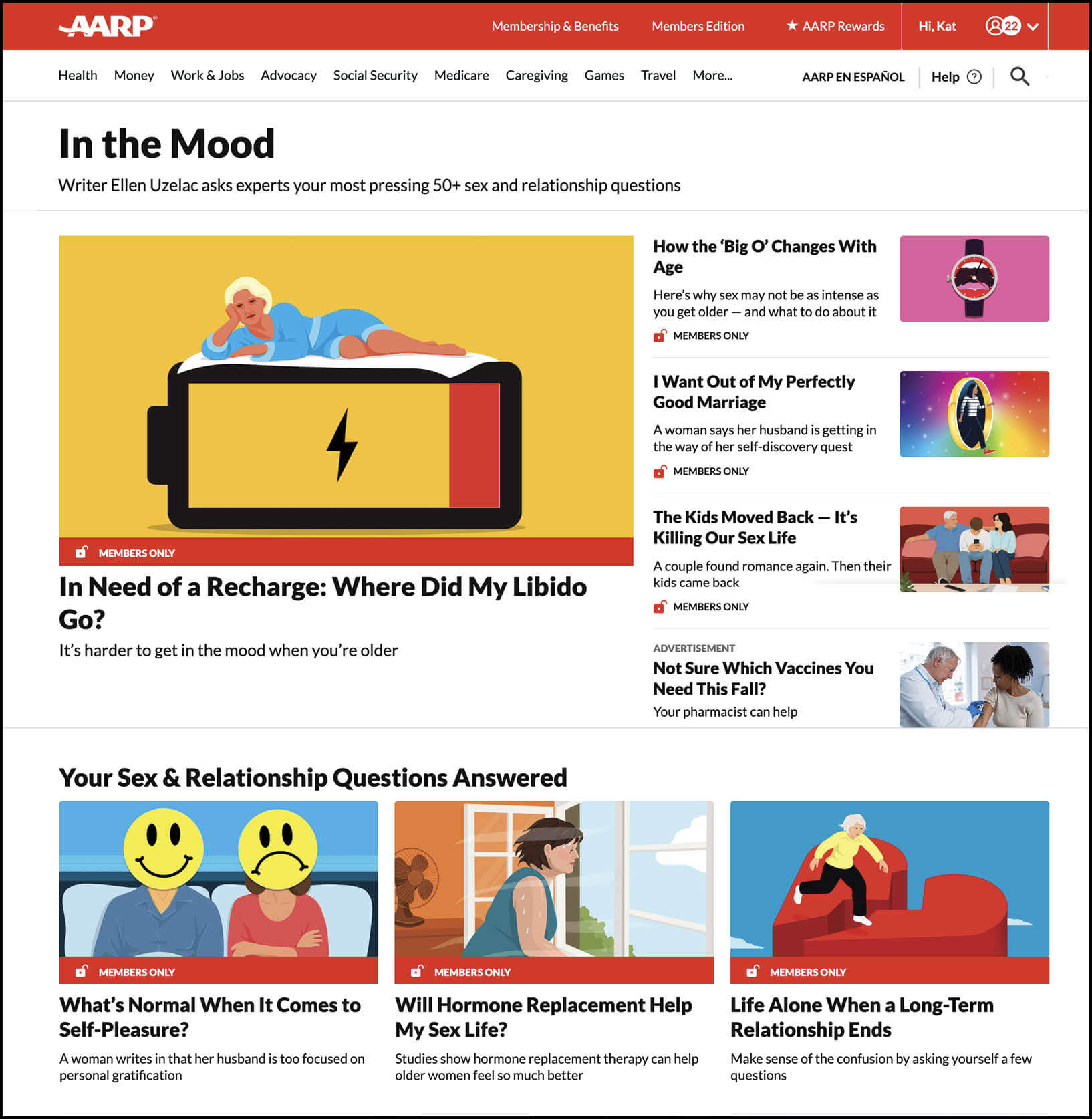Let’s Chat About Sex
Here’s what I’ve learned from writing a sex-advice column for older adults
By Ellen Uzelac
Photograph by stephanie diani

THERE ARE worse jobs to have than thinking about sex all day long. Seriously—I love it when people ask me what I do for a living. Who knew that in my 60s, I’d be writing a weekly sex-and-relationship column for AARP? Or that there’d be so much to say on the subject?
In the Mood has been around for a little over a year, and we’ve covered a lot of topics: erectile dysfunction, cheating spouses, self-pleasure … you name it.
The column has been warmly received, generating thousands of comments and queries from readers. My biggest fan, of all people, is my 97-year-old father, who is so proud of me and the awareness the column is building about sexuality for a 50-plus audience that is clearly hungry for information.
Of course, there are people who aren’t fans as well, and they’ve been vocal about it in their comments. “Inappropriate,” they write, or “filth,” or “not exactly the content I want to see.” I take the criticism in stride, comforted by the fact that they at least scrolled to the end of the column and wanted to add their voice to the conversation.
Here’s how the column works: Readers email questions to sexafter50@aarp.org. My editor and I select what we think are the most compelling ones—and the most relatable. I then draw on a deep bench of the nation’s topmost relationship, sexuality and medical experts, who offer insight and guidance on the issues our readers—both partnered and single—care most about.
In keeping with the Q&A format of the column, here are the questions I get asked most often about In the Mood.

The In the Mood page gets fresh updates every week—and has a deep archive you can dive into anytime.
How did you start writing about sex?
Several years ago, AARP THE MAGAZINE published an article I wrote about ending the five-year sex drought I experienced after my husband died. The headline? “Start Your Own Sexual Revolution.”
The piece got a lot of attention from AARP members—and the column, an outgrowth of that, premiered on AARP’s members-only web publication, Members Edition, in June 2024. I’ve had some great jobs—including travel writing that has taken me around the world—but nothing has been as consistently pleasurable and satisfying as answering questions from readers and, I hope, creating a pathway to help them build a healthier and happier relationship and sex life.
What issues come up the most among readers?
This one’s easy: the challenges of living in a sexless marriage, body image issues as we age, masturbation, sex toys for older adults and couples with different sex drives.
We also get a lot of queries about unreliable erections and dry vaginas, ways to spice up your sex play, and infidelity. Finally, many of our readers want to know what is and isn’t normal: “Is it normal for your private parts to change size as you age?” (Yes.) “Is it normal to want to leave a perfectly good marriage after 30 years?” (Yes, it’s fully normal to feel this way—though it doesn’t necessarily mean you should leave.) “My husband seems more interested in satisfying himself alone than with me. Is that normal?” (It happens more often than you might think.)
I’ve always enjoyed reporting and information gathering as much as, if not more than, writing. With In the Mood, that means researching the best new sex toys and googling topics like “time it takes to orgasm.” I shudder to think what my browser history looks like at this point.

How to live in a sexless marriage is a common question from readers.
What has most surprised you about the column?
A couple of things. First, the response to the column, which publishes online every Thursday, has been extraordinary. It’s among the most clicked-on content on AARP’s website, and it has become something of a brand. We now run occasional AARP-produced videos alongside the column that feature, for example, a certified sex therapist or a gynecologist, who do deep dives into the topic of the week. And stay tuned: In the Mood has some extra-special content headed your way.
The other surprise is how much I’ve learned. Every week, there’s something new—like the right and wrong way to wash your genitals and the average penis size (because I know you want to know: 5.5 inches erect, 3.5 flaccid). The column has also shined a light on some little-discussed topics, like how intimacy changes when a partner has cognitive decline, when it might be time to consult a sex therapist and when garden-variety arguments veer into emotional abuse.
What’s the biggest takeaway?
There are so many ways to make sex and intimacy more powerful and meaningful—no matter your age. The foundation for that: communication, which can be a tough one for many of us. How to get started? Be present. Center on your emotional self and your body. Once you do that, you can be more available to connect with your partner.
As certified sex therapist Nan Wise frames it: “What’s on my mind? What’s happening in my body? What’s happening with my emotional weather? Do the full circuit. Communication is really about communion.”
It has been incredibly rewarding to help readers as they navigate some of the toughest, but most important, questions about sex and relationships—especially since real, honest info on these topics specifically for older adults can be hard to find.
If you haven’t checked out In the Mood, please do. I promise you: There’s something here for everyone. Better yet, hit me with your questions. I’m happy to answer.
Ellen Uzelac is the former West Coast bureau chief for The Baltimore Sun. She writes frequently on sex, relationships, travel and lifestyle issues.
MEMBERS EDITION
Go to aarp.org/InTheMood to find the latest advice on relationships and sex over 50.
AARP (2)